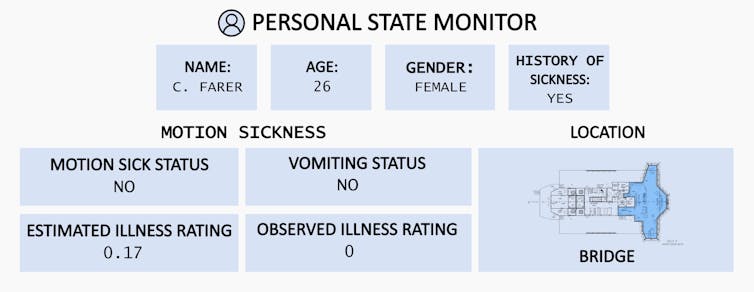I’ve always been intrigued by the ocean, drawn to its mystery and sheer immensity. So I was excited when, in 2019, I identified a topic for my postgraduate studies that gave me a chance to work aboard South Africa’s polar supply and research vessel, the SA Agulhas II.
My research was about people’s well-being while living and working aboard the ship. And, very soon into the trip, my own well-being took a knock: I developed motion sickness.
Motion sickness is triggered by a ship’s rocking motion (cars, aeroplanes and trains can have the same effect). The long list of symptoms can include tiredness, yawning, sweating, nausea, dizziness, vomiting and even bouts of depression.
My curiosity was piqued. Of course, others on the ship sometimes struggled with motion sickness, too. I wondered if was there any way to track my and others’ symptoms in real time. With my supervisors, professors Anriëtte Bekker and Karel Kruger, of Stellenbosch University’s Department of Mechanical and Mechatronic Engineering, I embarked on a PhD project to do just that.
The result is a digital platform called the Mariner 4.0. It functions in two ways. One, it measures the motion of a ship through sensors placed on board. Two, passengers can use a specially designed mobile app to log metrics about their symptoms, if any, and where they are on the ship (this is important because motion can differ noticeably from place to place on large ships).
The data is shown on a dashboard which can be accessed, by, for instance, a ship’s doctor to see who might need medical attention, or by the captain to potentially plot an altered course to minimise cases of motion sickness.
We tested the platform during three of the SA Agulhas II’s voyages, over a total of five months at sea, capturing and analysing data related to motion sickness in real time.
Causes of motion sickness
Motion sickness occurs when there is a conflict between what your eyes see and what your inner ears (vestibular system) sense about motion. When you’re on a ship your eyes may tell your brain that you are sitting or standing still. But your inner ears, which help maintain balance, detect the rocking and swaying motion of the ship. This mixed signal confuses your brain and leads to feelings of illness, discomfort and queasiness, among other possible symptoms.
Read more:
Motion sickness: it all started 550 million years ago
Interestingly, some people are more prone to motion sickness than others. Factors such as age, previous experiences with motion sickness and individual sensitivity to motion can all play a role. Even the type of ship and weather conditions can influence how severe the symptoms might be.
While conducting my research, I did not find any other reported digital system on board used to inform anyone about how motion sick passengers and crew members on board might be. If you should be dreadfully ill in your cabin, no one could know unless you personally reached out face-to-face or via telephone.
The Mariner 4.0 platform changes that.
The SA Agulhas II has been our laboratory on three voyages since 2021. Sensors have been placed at various places on the ship and we’ve recruited between five and 20 passengers at a time to install the app on their phones. Both the app and the sensors connect to the Mariner 4.0 platform.
Author provided (no reuse)
The app allows passengers to log metrics like whether they are motion sick or not (motion sickness incidence), how severe their symptoms are (using an illness rating) and where on board they are at the time.
The Mariner 4.0 platform brings the data from the shipboard sensors and passengers into a dashboard, such as the one shown in the figure below.

Dr Nicole Taylor, Author provided (no reuse)
This visual data can help those making decisions aboard a ship understand how best to support those who need medical attention, or whether a slight change in course could ease people’s symptoms.
A supportive tool
I’ve found the platform personally useful, too. During my three voyages (and counting) aboard the SA Agulhas II, I’ve been able to figure out which areas trigger my motion sickness and change my working patterns or locations on days when heavy swells – and more ship motion – are forecast.
Read more:
The South African ship that found Antarctica’s Endurance wreck is vital for climate science
The platform isn’t yet live; we’re continuing to tweak and update it as we learn more before making it more widely available. We hope that, in years to come, it will become a supportive tool not just for research ships, but for other seafaring vessels like ferries, fishing boats or yachts.



